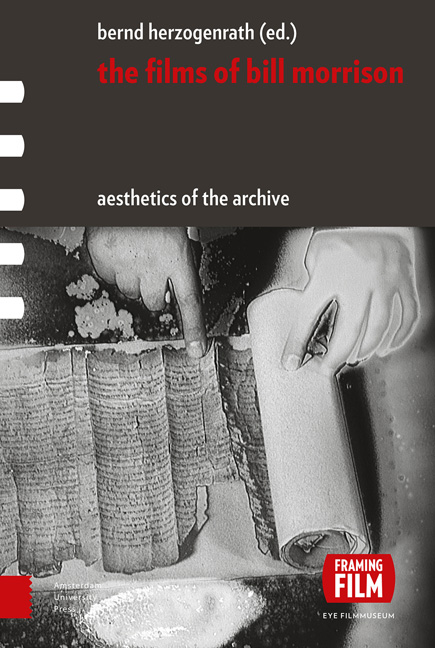Book contents
- Frontmatter
- Contents
- Acknowledgments
- Aesthetics of the Archive: An Introduction
- Chapter 1 Drafts and Fragments: Reflections around Bill Morrison and the Paper Print Collection
- Chapter 2 The Film of Her: The Cine-Poet Laureate of Orphan Films
- Chapter 3 Ghost Trip: Searching for Potential Myths
- Chapter 4 Decasia: The Matter | Image: Film is also a Thing
- Chapter 5 The Mesmerist: Illustrating the Return of the Repressed
- Chapter 6 Light is Calling: Celluloid Dreams
- Chapter 7 Gotham: Zoetrope: Block by Block
- Chapter 8 Outerborough: Early Cinema Revisited
- Chapter 9 The Highwater Trilogy: Thinking the Liquid – On the Ethics of Water and the Material Ecologies of Disaster and Ruination
- Chapter 10 Porch: Archives, Collective Memory, and the Poetics of Home Movies
- Chapter 11 The Future Lasts Long: The Romanov Lost Family Archives
- Chapter 12 Who by Water: Variations on Matter, Figures, Memory, and Mythology
- Chapter 13 Every Stop on the F-Train: Beyond and within the Restless Netherworld of (Manhattan’s) Mind
- Chapter 14 Spark of Being: Bachelor Machine
- Chapter 15 The Miners’ Hymns: Acts of Resurrection
- Chapter 16 Tributes – Pulse: A Requiem for the 20th Century: Death | Drive | Image
- Chapter 17 Just Ancient Loops: The Loops of Life in Intonation
- Chapter 18 The Great Flood: Water is Transparence Derived from the Presence of Everything
- Chapter 19 Re-Awakenings: Bill Morrison in Conversation
- Index of Film Titles
- Index of Names
- Index of Subjects
- Already Published
Aesthetics of the Archive: An Introduction
Published online by Cambridge University Press: 12 December 2020
- Frontmatter
- Contents
- Acknowledgments
- Aesthetics of the Archive: An Introduction
- Chapter 1 Drafts and Fragments: Reflections around Bill Morrison and the Paper Print Collection
- Chapter 2 The Film of Her: The Cine-Poet Laureate of Orphan Films
- Chapter 3 Ghost Trip: Searching for Potential Myths
- Chapter 4 Decasia: The Matter | Image: Film is also a Thing
- Chapter 5 The Mesmerist: Illustrating the Return of the Repressed
- Chapter 6 Light is Calling: Celluloid Dreams
- Chapter 7 Gotham: Zoetrope: Block by Block
- Chapter 8 Outerborough: Early Cinema Revisited
- Chapter 9 The Highwater Trilogy: Thinking the Liquid – On the Ethics of Water and the Material Ecologies of Disaster and Ruination
- Chapter 10 Porch: Archives, Collective Memory, and the Poetics of Home Movies
- Chapter 11 The Future Lasts Long: The Romanov Lost Family Archives
- Chapter 12 Who by Water: Variations on Matter, Figures, Memory, and Mythology
- Chapter 13 Every Stop on the F-Train: Beyond and within the Restless Netherworld of (Manhattan’s) Mind
- Chapter 14 Spark of Being: Bachelor Machine
- Chapter 15 The Miners’ Hymns: Acts of Resurrection
- Chapter 16 Tributes – Pulse: A Requiem for the 20th Century: Death | Drive | Image
- Chapter 17 Just Ancient Loops: The Loops of Life in Intonation
- Chapter 18 The Great Flood: Water is Transparence Derived from the Presence of Everything
- Chapter 19 Re-Awakenings: Bill Morrison in Conversation
- Index of Film Titles
- Index of Names
- Index of Subjects
- Already Published
Summary
Dubbed by Robert Koehler as ‘[o]ne of the most adventurous American filmmakers’ (Variety 12/11/11), director Bill Morrison was born in Chicago, Illinois in 1965 and he currently lives in New York. He attended Cooper Union, where he studied painting and animation. After college, he worked with New York's Ridge Theater, making short film backdrops for their avant-garde productions. This work has been recognized with two Bessie awards and an Obie Award.
Morrison's film and multimedia art has been screened at festivals, museums, and concert halls worldwide, including the Sundance Film Festival and the Tate Modern. The Museum of Modern Art has acquired eight of his titles for their permanent collection. The MoMa also hosted a mid-career retrospective of Morrison's work in October-November 2014.
His films are found in the collection of the Walker Art Center and the EYE Film Institute. Morrison has been commissioned to create films for numerous composers, including John Adams, Laurie Anderson, Gavin Bryars, Dave Douglas, Richard Einhorn, Bill Frisell, Michael Gordon, Henryk Gorecki, Vijay Iyer, Jóhann Jóhannsson, David Lang, Harry Partch, Steve Reich, and Julia Wolfe. Morrison has received the Alpert Award, as well as fellowships from Creative Capital, the Guggenheim Foundation, the Foundation for Contemporary Arts, and the NEA.
Decasia (2002), his feature-length collaboration with composer Michael Gordon, was described by The Village Voice film critic J. Hoberman as ‘the most widely praised American avant-garde film of the fin-de-siècle ’ (Hoberman 2007) and by Oscar-winning filmmaker Errol Morris as maybe ‘the greatest movie ever made’ (quoted in Weschler 2002). It was also was selected to the US Library of Congress’ 2013 National Film Registry, becoming the most modern film named to the list that preserves works of great cultural, historic or aesthetic significance to the nation's cinematic heritage. Writing in The New York Times Magazine, Lawrence Weschler wrote that watching the film, ‘I found myself completely absorbed, transfixed, a pillow of air lodged in my stilled, open mouth.’
In 2013, Morrison was honored with retrospective programs in four different countries: the Walker Art Museum, United States; the Vila Do Conde Short Film Festival, Portugal; the Adelaide Film Festival, Australia; and the Aarhus Film Festival, Denmark.
- Type
- Chapter
- Information
- The Films of Bill MorrisonAesthetics of the Archive, pp. 11 - 30Publisher: Amsterdam University PressPrint publication year: 2017
- 1
- Cited by



